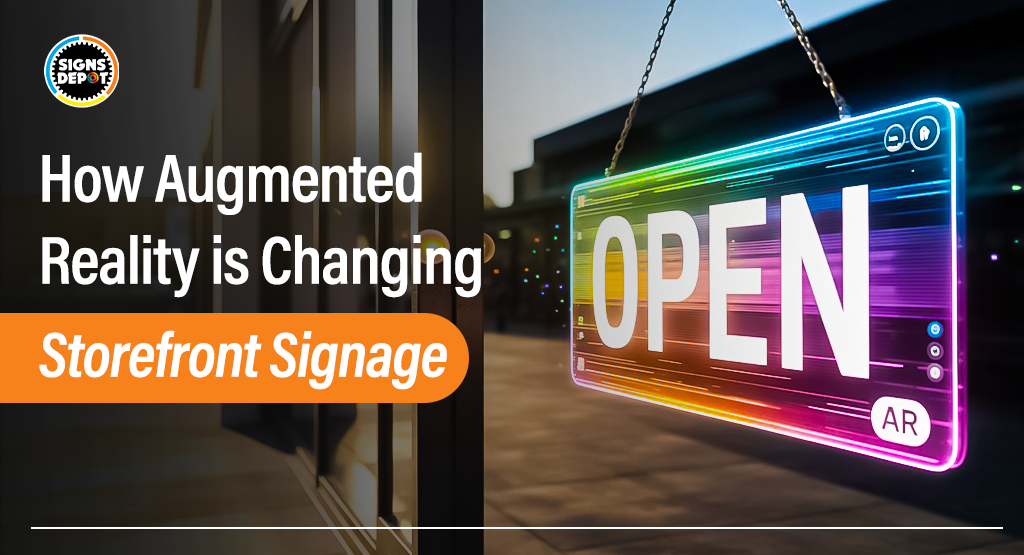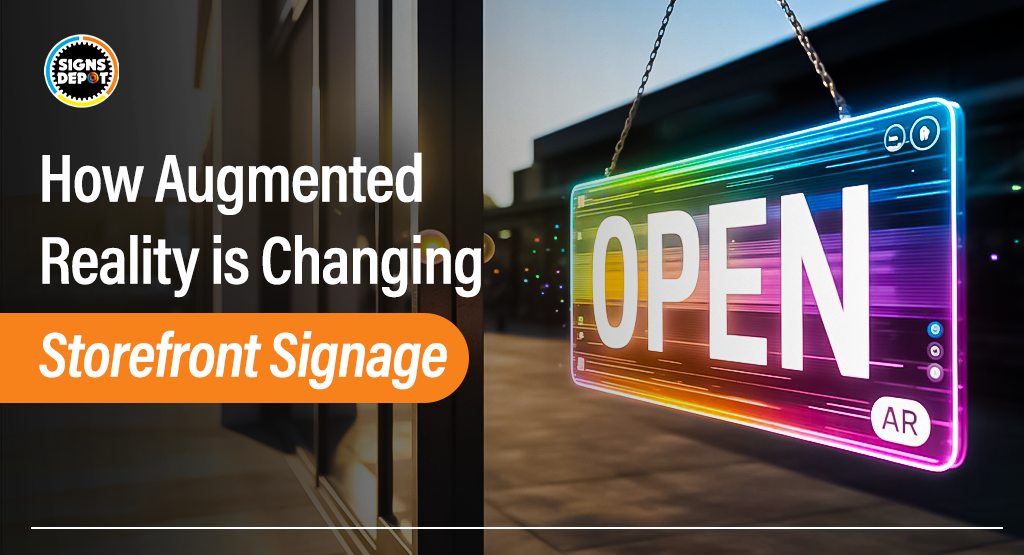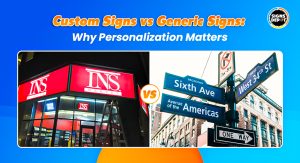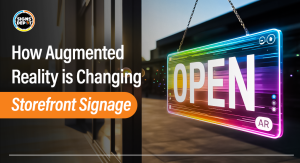

The usage of static posters, neon lights, and hand-painted window displays for storefront signs is no longer sufficient to capture your attention. Especially in a world where TikTok trends go viral in minutes, and consumers value experiences as much as products, shops are scrambling to separate apart. Enter augmented reality (AR), the technology that is transforming everyday stores into interactive playgrounds.
For example, think of yourself as walking down a storefront with a phone in hand when suddenly a clothing mannequin in a window gesture at you, transforms into your avatar and displays you are wearing the latest autumn collection. Sounds like science fiction, doesn’t it? Nope. AR is just doing its thing.
In this article, we’ll dive into how AR is revolutionizing storefront signage, how businesses connect with customers, blurring the lines between physical and digital, and why your local coffee shop might soon have a virtual barista greeting you from the sidewalk.
From Static to Stunning: What Exactly is AR Storefront Signage?
Augmented reality—or AR, if you’re into abbreviations—is basically like giving the real world a digital makeover. Think of it this way, you’re staring at a boring store window through your phone, and poof—suddenly there’s a cartoon mascot doing backflips over the mannequins or a 3D model of a coffee cup that “spills” virtual latte art onto the sidewalk.
It’s not sci-fi; it’s just your phone (or fancy AR glasses) sticking digital stuff onto what’s there. Unlike virtual reality, which plops you into a fake world (looking at you, VR headsets), AR jazzes up the world you’re already in.
So, imagine traditional storefront signs in Toronto as those old-school billboards you speed past on the highway, static, unchanging, and kinda forgettable. On the other hand, AR signage is like a billboard that notices you. It’s alive.
If it’s snow all over, the display might flip to showing fluffy sweaters and a virtual fireplace. If it’s 90 degrees out? it’s suddenly all pool floats and popsicles. In short, it’s signage with a brain and a serious flair for drama.
Why Retailers Are Ditching Paper Posters for Pixels
So why are brands shelling out cash for AR when a printed banner costs $50? Let’s break it down:
1. Interactivity That Actually Engages
Static signs are, well, static. They can’t respond to you. AR turns signage into a two-way conversation. For example, Nike’s AR-powered storefront signs in Toronto let shoppers “see” the inside of a sneaker by pointing their phones at the window.
As a result, customers lingered longer, and sales spiked. When people can play with a display, they’re more likely to remember and buy what they see.
2. Personalization
AR can tailor content in real-time. Imagine walking past a makeup store, and the window recognizes your age/gender (via anonymized data) and showcases products for you. Many cosmetic companies have apps that already let users try on lipstick shades via AR; applying this to storefronts could mean a virtual mascara wand batting at you from the glass. It might look creepy, but it is effective.
3. Dynamic Content Without the Manual Labor
Changing a traditional window display takes hours. With AR, retailers can swap visuals instantly. Holiday sale? Upload the promo. Back-to-school season? Boom—new theme. It’s like having a Ctrl+Z button for your storefront sign in Toronto.
4. Data, Data, Data
AR signage isn’t just flashy—it’s smart. It can track how many people interacted with the display, how long they engaged, and what actions they took (like scanning a QR code to enter the store). For retailers, this AR integrated in exterior signs in Toronto is gold.
Recommended reading: The Future of Smart Signboards in Business Spaces
AR in Action: Brands Already Winning the Game
Let’s talk about real-world magic that AR brings in attracting customers. Here are some examples of those who are nailing it with AR storefronts:
- IKEA’s “Virtual Showroom”: IKEA’s AR app, Place, lets users visualize furniture in their homes. Now imagine these scaled to storefronts: Walk by an IKEA window, point your phone, and see a full living room setup that you can customize on the spot. Couch too big? Swipe to a smaller one.
- Coca-Cola’s “Holiday AR Trucks”: During Christmas, Coca-Cola transformed delivery trucks into AR experiences. Scanning the truck with your phone unleashed dancing polar bears and Santa Claus handing out virtual coupons. If they can do it on wheels, imagine the possibilities for static storefronts.
- Gucci’s AR Try-Ons: Luxury brands are hopping on board too. Gucci’s AR storefronts let users “try on” limited-edition sneakers without stepping inside. For high-end shoppers, this blend of exclusivity and tech is irresistible.
Consult the best sign company in Toronto for AI-driven business signs.
The Experience Economy: Why Customers Can’t Get Enough
Here’s the thing: modern shoppers aren’t just buying products, they’re buying stories, memories, and Instagrammable moments. AR storefronts tap into this perfectly.
- Gamification: Remember Pokémon Go? Stores with AR Building signs in Toronto could create scavenger hunts. “Find the virtual golden ticket in our window to win 20% off!” Suddenly, shopping becomes a game, with more people interacting with it.
- Emotional Connections: A kids’ toy store could have AR characters wave at children as exterior signs in Toronto, creating a “wow” moment that parents associate with the brand. Emotions drive loyalty.
- 24/7 Engagement: Even when stores are closed, AR displays keep working. A nighttime passerby might interact with a virtual concierge or browse products through the window.
Recommended reading: Digital and Interactive Signage Trends 2025
But Wait—Is AR Just a Gimmick?
Skeptics might argue that AR is a flash-in-the-pan trend. Sure, poorly executed campaigns can feel gimmicky. But consider this:
- Tech is Improving Fast: Early AR required clunky apps. Now, WebAR lets users access experiences directly through browsers—no download needed.
- Gen Z Demands It: 65% of Gen Z shoppers prefer brands that offer AR experiences. Ignore them, and you risk becoming the next Blockbuster.
- Post-Pandemic Shift: COVID-19 made hygiene-conscious shoppers wary of touching screens or crowding into stores. AR bridges the gap between safety and experience.
Challenges: Not All Sunshine and Virtual Rainbows
Of course, AR storefronts aren’t without hurdles:
- Cost: Developing AR content isn’t cheap. Small businesses might struggle without big budgets.
- Tech Barriers: Not all customers know how to use AR. Education is key—think clear prompts like “Scan here with your camera!”
- Privacy Concerns: Cameras and data tracking can spook users. Transparency about data use is non-negotiable.
The Future: What’s Next for AR Signage?
AR has just began, and there is a lot to it that might be coming soon. Here are some examples of how AR signage can be changing in the future.
- AR Glasses Integration: Once devices like Apple’s Vision Pro go mainstream, AR storefronts will become seamless. No more fumbling with phones—just glance and interact.
- AI-Powered Customization: Future displays might use facial recognition (ethically, of course) to show products based on your past purchases or mood.
- Sustainability: Digital signage reduces waste from printed materials. Eco-conscious brands will flaunt this.
Augmented reality isn’t killing traditional signage; it’s evolving it. In a crowded retail landscape, AR gives businesses the tools to surprise, delight, and connect in ways a paper poster never could. Whether it’s a virtual fashion show in a window or a coffee cup that “steams” when you walk by, AR turns everyday shopping into an adventure.
So next time you pass a storefront, pull out your phone. You might just catch a glimpse of retail’s wild, wonderful future, one where the line between real and digital isn’t just blurred. It’s erased.
If you want to get similar storefront signage, contact Signs Depot.




